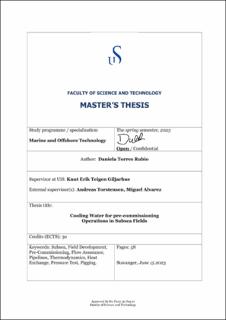| dc.description.abstract | Pre-commissioning in subsea oil and gas fields ensures the readiness for operation and integrity of the valves, pipelines, and various components installed on the seabed. A critical task in this process is the pressure testing of pipelines, which involves flooding them with fluids such as freshwater, seawater, or water-glycol mixtures. The testing fluid, initially stored in vessel tanks, is typically at ambient temperature. The high insulation in the subsea pipelines creates a significant temperature difference between the internal fluid used for pressure testing and the pipeline surroundings. This condition creates a false impression of pressure decrease due to temperature stabilization. Consequently, it becomes challenging to accurately identify leakages during pressure testing, resulting in prolonged offshore campaigns.
This study aims to investigate different solutions for efficiently cooling large amounts of water within a reasonable time frame under different spread configuration cases. Five different alternatives were studied: 1) Installation of a subsea spool with low insulation to allow for natural and forced convection cooling from the sea currents. 2) Single heat exchanger on the vessel deck. 3) Water chiller on the vessel deck. 4) Producing seawater using a desalination system and pumping the water from the seabed. 5) Theoretical reviews of developed patents for subsea heat exchangers.
Heat transfer calculations indicate the first two alternatives won't cover the objectives. First, The required length of the spool piece renders this alternative unfeasible. As for the heat exchanger, using seawater as a cold fluid limits the process final temperature. Two technologies are found to be more suitable for this application due to their extensive utilization in marine applications. First, the installation of a system similar to an RSW chiller, commonly used in fishing vessels to cool seawater and preserve the catch. Capacity calculations for this project result in average ranges for this type of equipment. Alternatively, the installation of a desalination system provides a different approach to the problem, however, the outlet temperature of the water is limited to the minimum achievable seawater temperature, which, in turn, is restricted by the capacity and installed depth of a subsea pump.
Considering the advantages of using a chiller system on a vessel, an economic evaluation was performed using quotations for this system. The interviewed providers offered the option to purchase the system instead of renting when compared to the assumed daily rate of a diving vessel, acquiring a unit like this becomes profitable. The initial investment can even be recouped in a single project, and operational time in offshore campaigns will be significantly reduced while decreasing at the same time the company's CO2 emissions. | |
